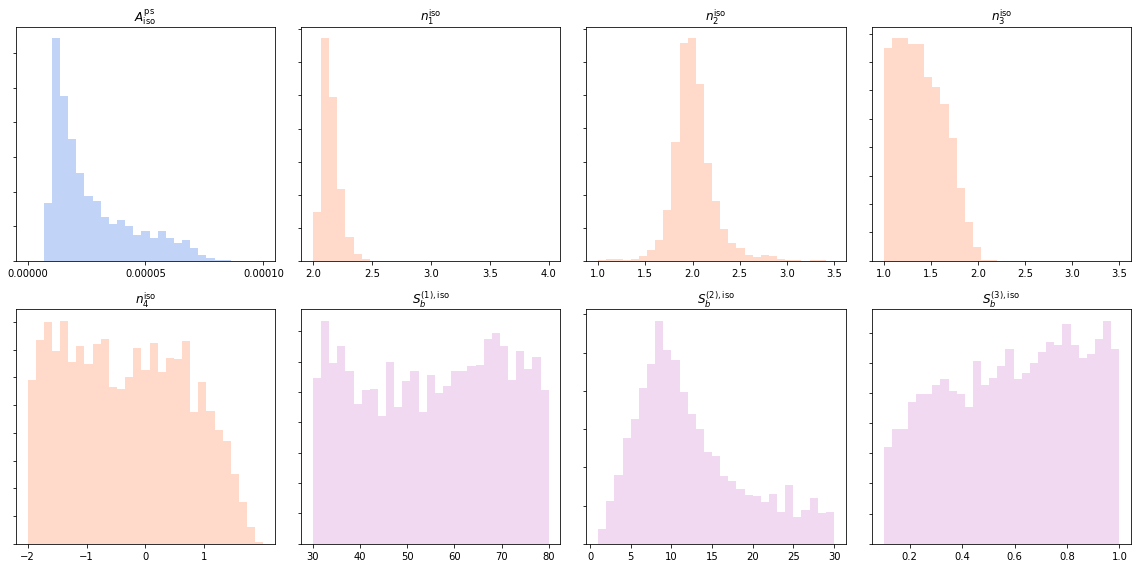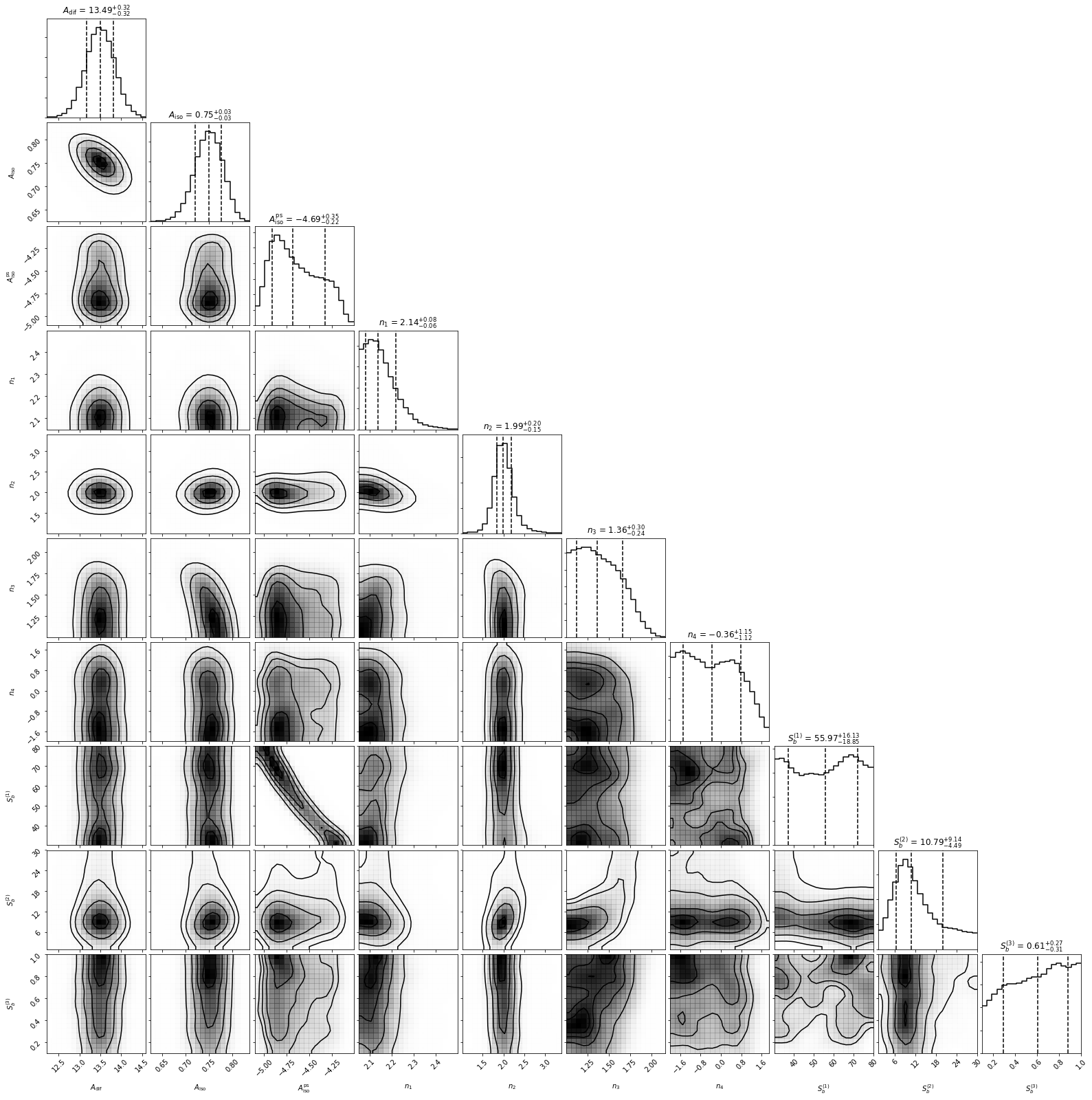Example 10: Analyzing the Results of the High-Lat Run¶
In this Example we analyze the results of an MPI run of NPTFit performed over high latitudes.
The example batch script we provide, Example10_HighLat_Batch.batch
is for SLURM. This calls the run file Example10_HighLat_Run.py using
MPI, and is an example of how to perform a more realistic analysis using
NPTFit.
NB: The batch file must be run before this notebook.
NB: This example makes use of the Fermi Data, which needs to already be installed. See Example 1 for details.
In this example, we model the source-count function as a triply-broken power law. In detail, the source count function is then:
and is thereby described by the following eight parameters:
This provides an example of a more complicated source count function, and also explains why the run needs MPI.
# Import relevant modules
%matplotlib inline
%load_ext autoreload
%autoreload 2
import numpy as np
import corner
import matplotlib.pyplot as plt
from NPTFit import nptfit # module for performing scan
from NPTFit import create_mask as cm # module for creating the mask
from NPTFit import dnds_analysis # module for analysing the output
from NPTFit import psf_correction as pc # module for determining the PSF correction
from __future__ import print_function
Load in scan¶
We need to create an instance of nptfit.NPTF and load in the scan
performed using MPI.
n = nptfit.NPTF(tag='HighLat_Example')
fermi_data = np.load('fermi_data/fermidata_counts.npy').astype(np.int32)
fermi_exposure = np.load('fermi_data/fermidata_exposure.npy')
n.load_data(fermi_data, fermi_exposure)
analysis_mask = cm.make_mask_total(band_mask = True, band_mask_range = 50)
n.load_mask(analysis_mask)
dif = np.load('fermi_data/template_dif.npy')
iso = np.load('fermi_data/template_iso.npy')
n.add_template(dif, 'dif')
n.add_template(iso, 'iso')
n.add_template(np.ones(len(iso)), 'iso_np', units='PS')
n.add_poiss_model('dif','$A_\mathrm{dif}$', [0,20], False)
n.add_poiss_model('iso','$A_\mathrm{iso}$', [0,5], False)
n.add_non_poiss_model('iso_np',
['$A^\mathrm{ps}_\mathrm{iso}$',
'$n_1$','$n_2$','$n_3$','$n_4$',
'$S_b^{(1)}$','$S_b^{(2)}$','$S_b^{(3)}$'],
[[-6,2],
[2.05,5],[1.0,3.5],[1.0,3.5],[-1.99,1.99],
[30,80],[1,30],[0.1,1]],
[True,False,False,False,False,False,False,False])
pc_inst = pc.PSFCorrection(psf_sigma_deg=0.1812)
f_ary, df_rho_div_f_ary = pc_inst.f_ary, pc_inst.df_rho_div_f_ary
Loading the psf correction from: /zfs/nrodd/NPTFRemakeExamples/psf_dir/gauss_128_0.181_10_50000_1000_0.01.npy
n.configure_for_scan(f_ary=f_ary, df_rho_div_f_ary=df_rho_div_f_ary, nexp=5)
The number of parameters to be fit is 10
Finally, load the completed scan performed using MPI.
n.load_scan()
analysing data from /zfs/nrodd/NPTFRemakeExamples/chains/HighLat_Example/.txt
Analysis¶
As in Example 9 we first initialize the analysis module. We will provide the same basic plots as in that notebook, where more details on each option is provided.
an = dnds_analysis.Analysis(n)
2. Get Intensities¶
print("Iso NPT Intensity",corner.quantile(an.return_intensity_arrays_non_poiss('iso_np'),[0.16,0.5,0.84]), "ph/cm^2/s")
print("Iso PT Intensity",corner.quantile(an.return_intensity_arrays_poiss('iso'),[0.16,0.5,0.84]), "ph/cm^2/s")
print("Dif PT Intensity",corner.quantile(an.return_intensity_arrays_poiss('dif'),[0.16,0.5,0.84]), "ph/cm^2/s")
Iso NPT Intensity [1.13023625e-07 1.21451391e-07 1.29983760e-07] ph/cm^2/s
Iso PT Intensity [1.62091903e-07 1.68566455e-07 1.74563161e-07] ph/cm^2/s
Dif PT Intensity [1.88574352e-07 1.93195545e-07 1.97764592e-07] ph/cm^2/s
3. Plot Source Count Distributions¶
an.plot_source_count_median('iso_np',smin=0.01,smax=1000000,nsteps=10000,color='tomato',spow=2)
an.plot_source_count_band('iso_np',smin=0.01,smax=1000000,nsteps=10000,qs=[0.16,0.5,0.84],color='tomato',alpha=0.3,spow=2)
plt.yscale('log')
plt.xscale('log')
plt.xlim([1e-12,5e-6])
plt.ylim([5e-14,1e-11])
plt.tick_params(axis='x', length=5, width=2, labelsize=18)
plt.tick_params(axis='y', length=5, width=2, labelsize=18)
plt.ylabel('$F^2 dN/dF$ [counts cm$^{-2}$s$^{-1}$deg$^{-2}$]', fontsize=18)
plt.xlabel('$F$ [counts cm$^{-2}$ s$^{-1}$]', fontsize=18)
plt.title('High Latitudes Isotropic NPTF', y=1.02)
Text(0.5,1.02,'High Latitudes Isotropic NPTF')
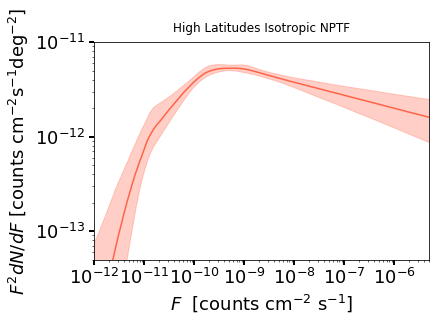
4. Plot Intensity Fractions¶
an.plot_intensity_fraction_non_poiss('iso_np', bins=100, color='tomato', label='Iso PS')
an.plot_intensity_fraction_poiss('iso', bins=100, color='cornflowerblue', label='Iso')
an.plot_intensity_fraction_poiss('dif', bins=100, color='plum', label='Dif')
plt.xlabel('Flux fraction (%)')
plt.legend(fancybox = True)
plt.xlim(0,80);
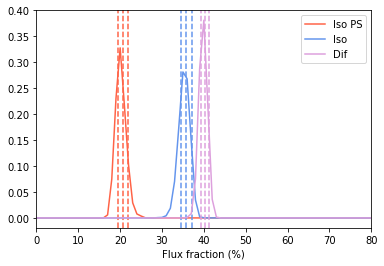
5. Access Parameter Posteriors¶
Poissonian parameters¶
Aiso_poiss_post = an.return_poiss_parameter_posteriors('iso')
Adif_poiss_post = an.return_poiss_parameter_posteriors('dif')
f, axarr = plt.subplots(1, 2);
f.set_figwidth(8)
f.set_figheight(4)
axarr[0].hist(Aiso_poiss_post, histtype='stepfilled', color='cornflowerblue', bins=np.linspace(.5,1,30),alpha=0.4);
axarr[0].set_title('$A_\mathrm{iso}$')
axarr[1].hist(Adif_poiss_post, histtype='stepfilled', color='lightsalmon', bins=np.linspace(10,15,30),alpha=0.4);
axarr[1].set_title('$A_\mathrm{dif}$')
plt.setp([a.get_yticklabels() for a in axarr[:]], visible=False);
plt.tight_layout()
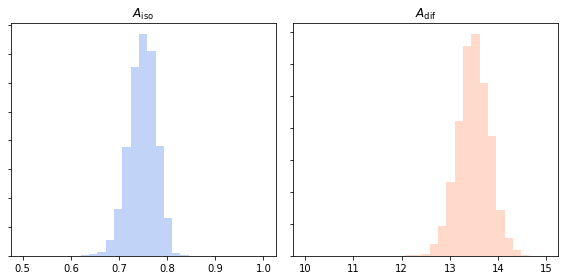
Non-poissonian parameters¶
Aiso_non_poiss_post, n_non_poiss_post, Sb_non_poiss_post = an.return_non_poiss_parameter_posteriors('iso_np')
f, axarr = plt.subplots(2, 4);
f.set_figwidth(16)
f.set_figheight(8)
axarr[0, 0].hist(Aiso_non_poiss_post, histtype='stepfilled', color='cornflowerblue', bins=np.linspace(0,.0001,30),alpha=0.4);
axarr[0, 0].set_title('$A_\mathrm{iso}^\mathrm{ps}$')
axarr[0, 1].hist(n_non_poiss_post[0], histtype='stepfilled', color='lightsalmon', bins=np.linspace(2,4,30),alpha=0.4);
axarr[0, 1].set_title('$n_1^\mathrm{iso}$')
axarr[0, 2].hist(n_non_poiss_post[1], histtype='stepfilled', color='lightsalmon', bins=np.linspace(1,3.5,30),alpha=0.4);
axarr[0, 2].set_title('$n_2^\mathrm{iso}$')
axarr[0, 3].hist(n_non_poiss_post[2], histtype='stepfilled', color='lightsalmon', bins=np.linspace(1,3.5,30),alpha=0.4);
axarr[0, 3].set_title('$n_3^\mathrm{iso}$')
axarr[1, 0].hist(n_non_poiss_post[3], histtype='stepfilled', color='lightsalmon', bins=np.linspace(-2,2,30),alpha=0.4);
axarr[1, 0].set_title('$n_4^\mathrm{iso}$')
axarr[1, 1].hist(Sb_non_poiss_post[0], histtype='stepfilled', color='plum', bins=np.linspace(30,80,30),alpha=0.4);
axarr[1, 1].set_title('$S_b^{(1), \mathrm{iso}}$')
axarr[1, 2].hist(Sb_non_poiss_post[1], histtype='stepfilled', color='plum', bins=np.linspace(1,30,30),alpha=0.4);
axarr[1, 2].set_title('$S_b^{(2), \mathrm{iso}}$')
axarr[1, 3].hist(Sb_non_poiss_post[2], histtype='stepfilled', color='plum', bins=np.linspace(0.1,1,30),alpha=0.4);
axarr[1, 3].set_title('$S_b^{(3), \mathrm{iso}}$')
plt.setp(axarr[0, 0], xticks=[x*.00005 for x in range(3)])
plt.setp(axarr[1, 0], xticks=[x*1.-2.0 for x in range(4)])
plt.setp(axarr[1, 3], xticks=[x*0.2+0.2 for x in range(5)])
plt.setp([a.get_yticklabels() for a in axarr[:, 0]], visible=False);
plt.setp([a.get_yticklabels() for a in axarr[:, 1]], visible=False);
plt.setp([a.get_yticklabels() for a in axarr[:, 2]], visible=False);
plt.setp([a.get_yticklabels() for a in axarr[:, 3]], visible=False);
plt.tight_layout()
